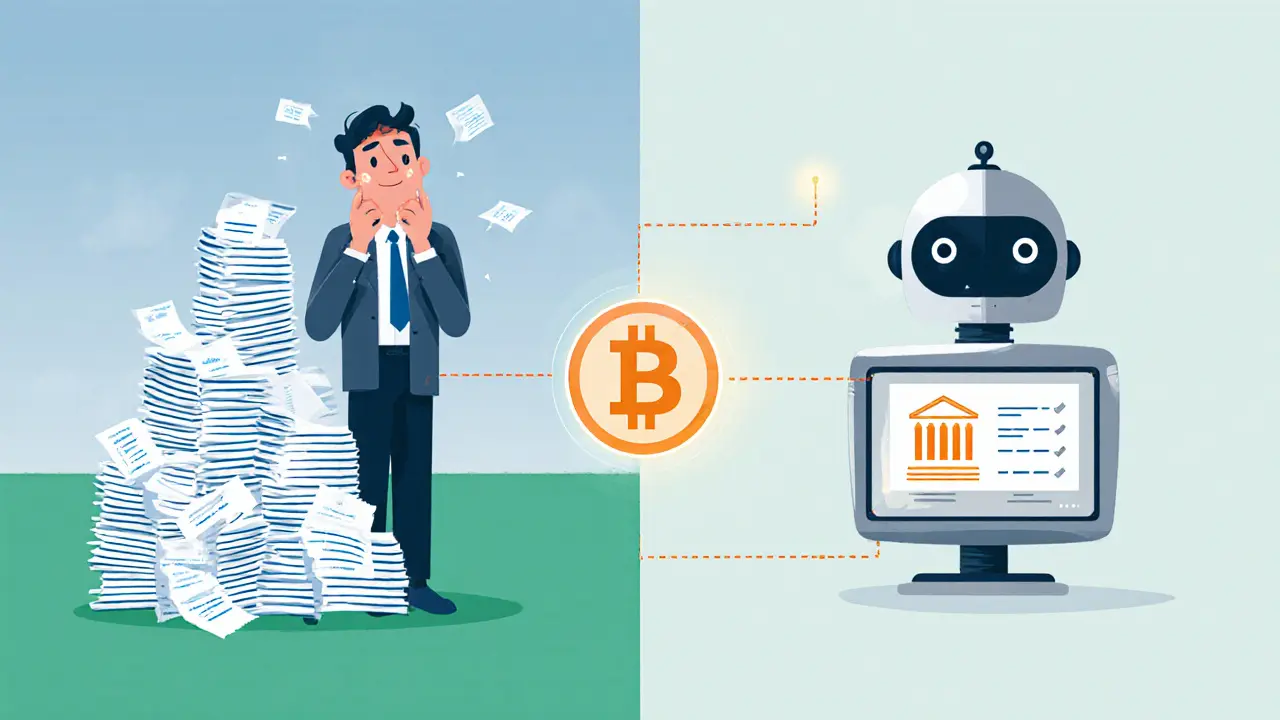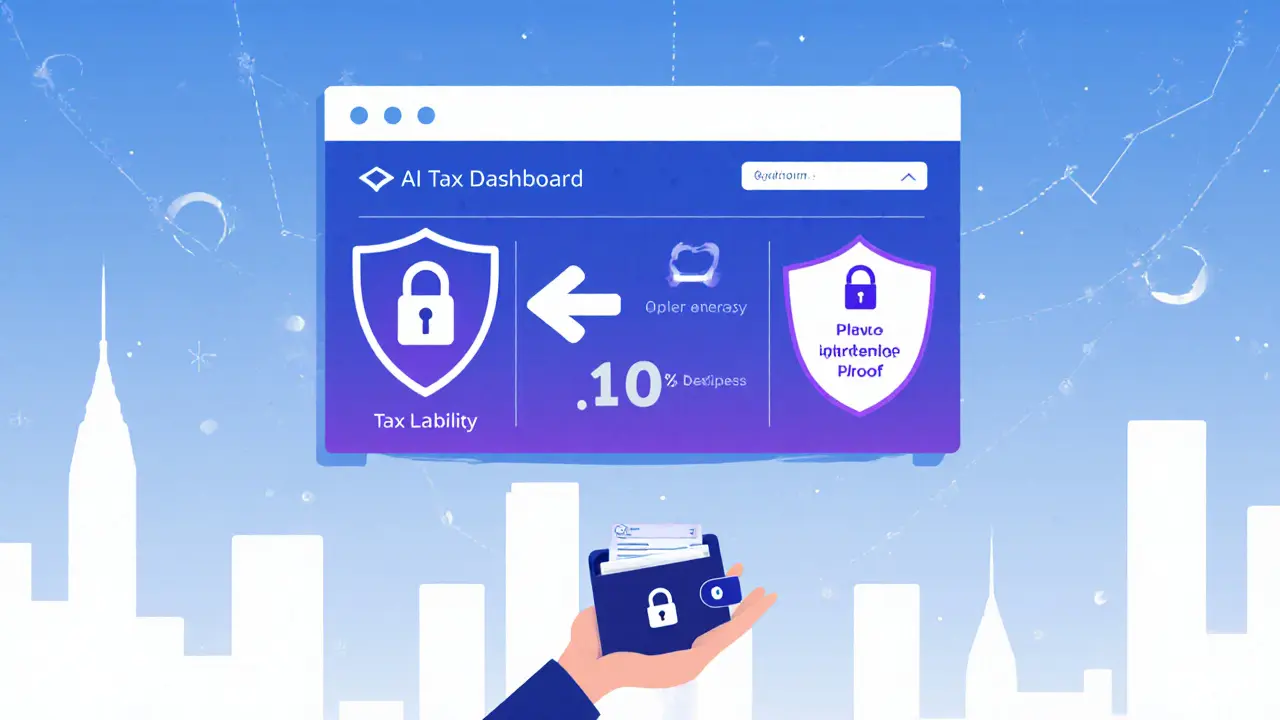Automated Crypto Tax Reporting: 2025 Outlook and Future Trends
 May, 31 2025
May, 31 2025
Crypto Tax Compliance Checker
Find Your Applicable Tax Regulations
This tool will help you determine which crypto tax regulations apply to you based on your location and activities.
When governments demand real‑time visibility into every Bitcoin swap, every NFT sale, and every DeFi stake, the old spreadsheet‑and‑receipt method simply can’t keep up. crypto tax reporting is moving from a manual nightmare to an algorithm‑driven service that talks directly to tax authorities. This shift isn’t a futuristic fantasy-it’s happening now, driven by the OECD’s CARF framework, the EU’s DAC8 directive, and the U.S. IRS’s new Form 1099‑DA requirement. In the next few sections you’ll see exactly how the ecosystem is changing, what tech makes it possible, and how you can stay compliant without drowning in data.
Regulatory Landscape in 2025
Automated Crypto Tax Reporting is a global, standardized system that automatically exchanges cryptocurrency transaction data between exchanges, wallet providers, and tax administrations. The system’s legal backbone started with the OECD’s Crypto‑Asset Reporting Framework (CARF) in 2022, matured through pilot programs in 2023‑24, and became fully operational in early 2025.
- EU DAC8 - Adopted in October 2023, effective 1 January 2025, forces every platform serving EU residents to submit a machine‑readable XML file to national tax authorities.
- U.S. Form 1099‑DA - Introduced by IRS Notice 2024‑39; starting 2026, U.S. exchanges must deliver a 1099‑DA for every taxable crypto transaction.
- Global CARF network - By July 2025, 112 tax administrations exchange data via a common XML schema, processing 1.2 million reports each month (ICAP).
The IMF’s 2024 Global Crypto Tax Compliance Report warned of a $10 billion annual tax gap. Thomson Reuters now estimates that 83 % of crypto‑related revenue will flow through these automated channels, dramatically cutting the gap.
Technical Architecture Behind the Automation
Three layers make the whole system work:
- Blockchain analytics engines - Providers like Chainalysis Reactor 6.3 and Elliptic Horizon 2025 run pattern‑recognition models that attribute transactions to wallets with 98.7 % accuracy, handling up to 1.2 million transactions per second across 28 chains.
- Standardized data exchange - The CARF XML Schema 2.1 defines 37 mandatory fields (wallet address, timestamp to the millisecond, asset class per MiCA, cost basis, etc.). This schema is the lingua franca for DAC8, 1099‑DA, and CARF reports.
- AI‑powered reconciliation - Tax authorities use AI to match incoming data with declared income, flagging anomalies in real time. The IRS’s Real‑Time Blockchain Monitoring Unit, launched February 2025, reaches 89.3 % accuracy on wallet‑to‑wallet transfers.
Latency measurements show impressive speed: 72 ms for centralized exchange feeds, 4.2 s for DeFi protocols, and the IRS’s Digital Asset Transaction System (DATS) processes 1.8 billion daily transactions.
Implementation Models: EU vs. US vs. Global
| Feature | EU DAC8 | US Form 1099‑DA | OECD CARF |
|---|---|---|---|
| Scope | All platforms serving EU residents | US‑based exchanges & US taxpayers | Multilateral, 112 jurisdictions |
| Data standard | CARF XML (mandatory) | IRS‑specific XML (based on CARF) | CARF XML 2.1 |
| Cross‑border capture | 84 % | 76 % | 92 % |
| Enforcement | Fines up to €1 M | Penalties up to $10 K per omission | Joint OECD sanctions |
| Asset classification | MiCA tiered token system | US Treasury categories | MiCA‑aligned |
| DeFi coverage | 63 % (Uniswap v3) | 45 % (major DEXes) | Varies by jurisdiction |
KPMG’s 2025 Global Tax Tech Assessment gave the CARF model an 8.7/10, praising its high cross‑border capture rate. The U.S. approach scores lower on global data sharing, while the EU shines in asset classification but lags on DeFi inclusion.
Remaining Pain Points: DeFi, NFTs, and Privacy
Even with sophisticated engines, three areas still cause headaches:
- DeFi staking and liquidity pools - Only 31 % of platforms correctly calculate taxable events. TokenTax’s Q1 2025 analysis showed cost‑basis miscalculations in 28 % of cross‑chain staking cases.
- NFT royalties - 47 % of royalty income remains unreported (NonFungible.com, 2025). The updated CARF schema added NFT royalty fields, but many marketplaces have not yet integrated the API.
- Privacy concerns - Reddit users report a 74 % worry level about sharing wallet addresses with tax authorities. MIT’s Digital Currency Initiative flagged that the breadth of data collected exceeds revenue‑collection needs.
Providers are responding: Koinly’s Protocol Tax Engine now supports 1,247 protocol‑specific rules, and several firms are piloting decentralized identity solutions that let users prove compliance without exposing full transaction histories.
Market Growth and Competitive Landscape
The crypto tax software market jumped to $5.04 billion in 2025, a 20 % YoY increase. North America holds 48 % of the revenue, Europe 32 %, and APAC 20 %. Leading players include:
- CoinTracker - 38 % market share for exchange reporting.
- CryptoTaxCalculator - 42 % share in DeFi/NFT niche.
- TokenTax - Strong in corporate compliance, especially Fortune‑100 adoption.
Trustpilot scores average 4.1/5, with praise for automated exchange integration and criticism for DeFi complexity. Support tickets for DeFi questions rose by 220 % in Q2 2025, highlighting the need for more robust protocol handling.

Practical Steps for Tax Professionals and Retail Users
Getting up to speed now is less daunting than in 2023. The AICPA reports that learning time dropped from 80 hours to 22 hours thanks to standardized APIs.
- Connect your exchange APIs - Most major VASPs (Coinbase, Binance, Kraken) support the required API within 48 hours. Follow the IRS Technical Guide 1099‑DA‑3 for precise endpoint URLs.
- Verify wallet addresses - Expect 2‑5 business days for address‑ownership confirmation. Use Chainalysis’s address‑verification tool to reduce errors.
- Calibrate for asset types - Load the CARF schema into your tax software, then activate modules for NFTs, staking, and liquidity pools. Koinly’s new Protocol Tax Engine can auto‑populate 1,247 rule sets.
- Run a reconciliation test - Generate a sandbox report, compare it with your self‑declaration, and address any mismatches before the filing deadline.
- Document privacy safeguards - Keep a log of data requests, use encryption per EU Cyber Resilience Act, and consider decentralized identity wallets for future compliance.
Hiring a dedicated blockchain tax specialist is becoming the norm; 78 % of CPA firms now have at least one such professional on staff, with an average salary of $142,500 (Robert Half, 2025).
Future Outlook: 2026‑2030
Looking ahead, four major trends will shape the space:
- AI‑driven tax optimization - By 2026, AI engines will suggest cost‑basis strategies that minimize taxable events while staying within regulatory bounds.
- Global asset‑classification harmonization - The OECD targets a 2027 CARF revision that aligns all jurisdictions on a single token tier system.
- Privacy‑preserving compliance - Decentralized identity frameworks (e.g., DID‑based proofs) are in OECD pilot tests, aiming to let users prove taxable income without full transaction disclosure.
- Quantum‑resistant encryption - EU’s Cyber Resilience Act 2025 mandates post‑quantum cryptography for tax data exchanges, ensuring future‑proof security.
Deloitte predicts that by 2027 crypto tax reporting will be fully embedded in standard financial statements, eliminating the need for separate crypto workflows. The World Economic Forum’s Digital Taxation Roadmap foresees 8.2 billion daily crypto tax transactions by 2030-on par with SWIFT payment volume.
What is the difference between DAC8 and Form 1099‑DA?
DAC8 applies to any platform serving EU residents, forcing a uniform XML report to each member‑state. Form 1099‑DA is a U.S. requirement that only U.S.-based exchanges must file for U.S. taxpayers. Both use the CARF schema, but DAC8 has broader geographic reach while 1099‑DA is narrower but more detailed for U.S. tax code elements.
How accurate are blockchain analytics providers?
Studies from MIT’s Digital Currency Initiative rank Chainalysis Reactor 6.3 and Elliptic Horizon 2025 at 98.7 % transaction attribution accuracy, handling over a million transactions per second across leading blockchains.
Will my NFT royalties be automatically reported?
The July 2025 CARF update added 12 fields for NFT royalty tracking, but many marketplaces haven’t implemented the API yet. Until they do, you’ll need to manually import royalty data or use a tax software that supports manual entry.
What skills should a tax professional develop for 2025?
Blockchain literacy tops the list-understanding wallet structures, transaction types, and DeFi protocols. CPA firms are hiring dedicated blockchain tax specialists, and certifications from the AICPA’s Blockchain Tax program are increasingly valued.
How can I protect my privacy while complying?
Consider using decentralized identity wallets that issue zero‑knowledge proofs of compliance. Meanwhile, ensure any data you share is encrypted with post‑quantum algorithms, as required by the EU Cyber Resilience Act.
Kevin Johnston
October 25, 2025 AT 10:45Lena Novikova
October 25, 2025 AT 15:09Derajanique Mckinney
October 25, 2025 AT 17:28Paul Lyman
October 26, 2025 AT 15:42MICHELLE SANTOYO
October 27, 2025 AT 02:29Saurav Deshpande
October 27, 2025 AT 20:03gurmukh bhambra
October 28, 2025 AT 07:20Dr. Monica Ellis-Blied
October 29, 2025 AT 04:17Herbert Ruiz
October 29, 2025 AT 20:28Olav Hans-Ols
October 30, 2025 AT 08:39Sunny Kashyap
October 30, 2025 AT 23:53Rosanna Gulisano
October 31, 2025 AT 13:32Sheetal Tolambe
October 31, 2025 AT 23:10Frech Patz
November 1, 2025 AT 12:47